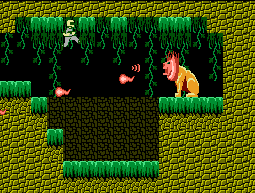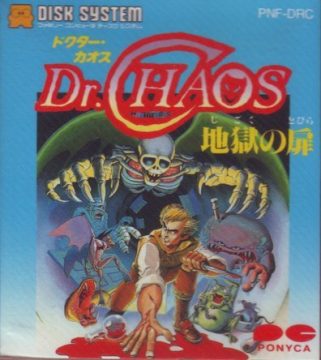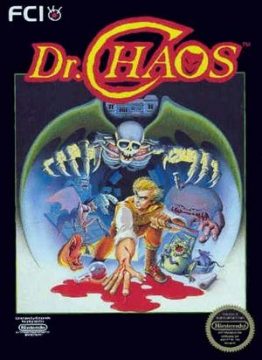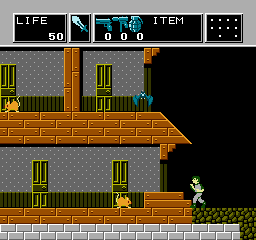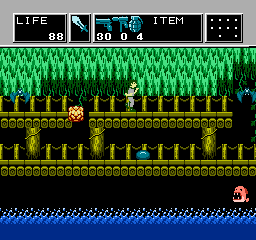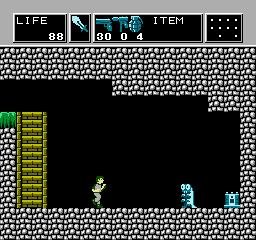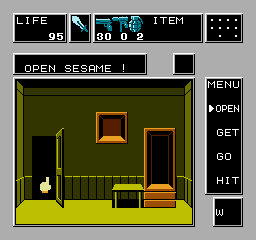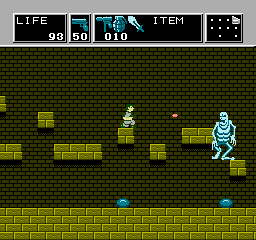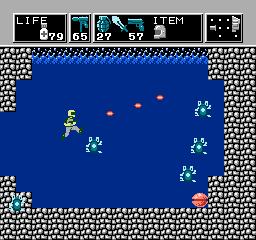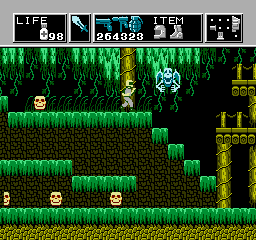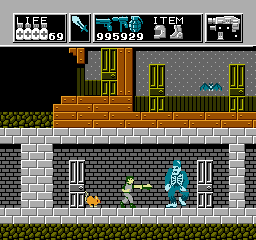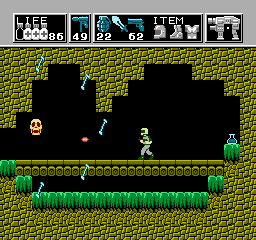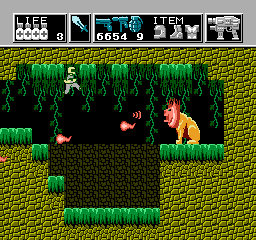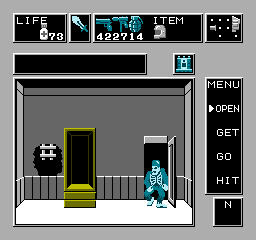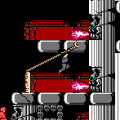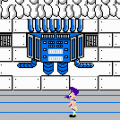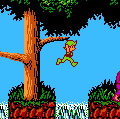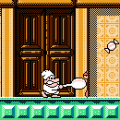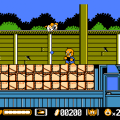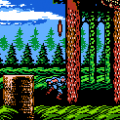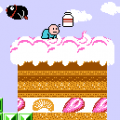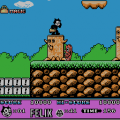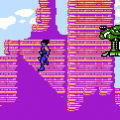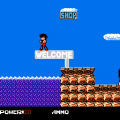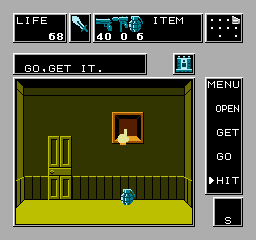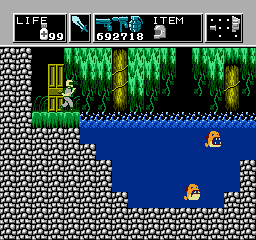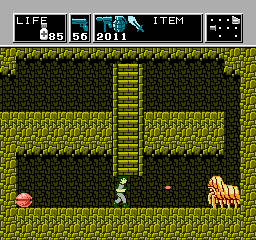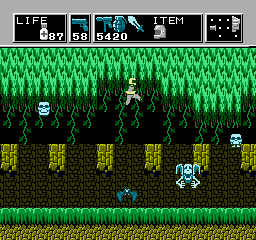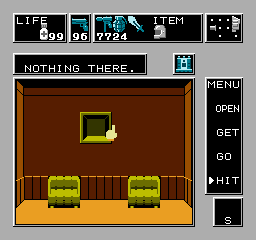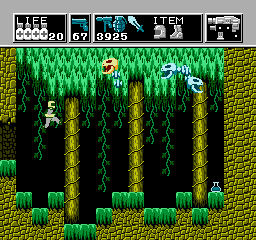Every game system has its super A-list golden games and franchises that everyone knows, terrible games that are notorious for their crappiness, lesser-known sleeper hits which have their fans, bland and/or mediocre games which aren’t really worth talking about, and finally, those incredibly bizarre games that no one really knows how to qualify. To take the Nintendo Entertainment System for example, you have Super Mario Bros. 3for “golden,” Bible Adventures for “notorious,” The Guardian Legend for “sleeper,” several titles for “mediocre” based on various movie licenses, and… Dr. Chaos, filed under “other.” Dr. Chaos is not the best game on the NES. It is even arguable as to whether or not it is a good game. But it is an incredibly weird one that warrants examination on what it tries to do and often ends up failing.
To start, the game is about an intrepid young lad with the ostensibly awesome name “Michael Chaos.” Too bad this name belongs to a total dork, but we’ll examine that later. The manual details the scant storyline, wherein Michael is worried about the state of his brother, the eponymous Dr. Ginn Chaos, a quantum physicist whose experiments involves portals to bizarre new dimensions called “warp zones.” Ginn’s last report to his brother claims he finally created warp zones, but since Michael hasn’t heard from Ginn in three months, he heads out to his brother’s lab, which just so happens to be a creepy mansion out in the middle of nowhere. Michael gets there to find his brother missing and the mansion overrun by inhuman creatures, but a letter from Ginn warns him about how these monsters came out of the warp zones and how Michael is the only one that can stop them from coming through. Defeating these vile entities apparently involves diving into warp zones and retrieving pieces for a giant laser gun and using it to kill the head monster, Canbarian. Can Michael rescue his brother and destroy the warp zones forever? If only.
Dr. Chaos is something of an odd action/adventure hybrid with vague elements of proto-survival horror, and it attempts to meld active and passive gameplay into the same pot. There are three different phases to exploring the house: The hallway, rooms, and warp zones. The “hallway” is defined as the expanse of the mansion itself taking place in a 2D action-platformer sort of perspective. “Rooms” are behind the doors in the hallway, and when you enter one of these, the perspective changes entirely from 2D action to 3D exploration, where you explore the room via a cursor and menu-based interface. “Warp zones” are the real “levels” of the game and are also 2D action scenes, except the emphasis on said action is much greater than in hallways. The action parts play out like your standard platformer, with one button to jump, another to attack, and a third to switch weapons. Enemies range from one-hit weaklings which are annoying to kill, to larger and bulkier demons which may take several shots to snuff. You start out with fifty health points, and running out of all those kicks you back to the front gate of the mansion with all of your ammunition taken away, though you can keep whatever important items you’ve retrieved from the ends of warp zones.
Michael brings a total of three weapons to the house: A knife, a pistol, and a submachine gun. Except he didn’t even think to load any bullets into either of his guns, so the doofus starts out with his knife and nothing else. Expectedly, the knife is short-ranged and weak, but it’s all you got to start. At first, you’ll mostly be dealing with nuisance enemies like rats and bats, so sticking to the knife until you conveniently find ammunition strewn about the house is the only way to go. Ammo for your weapons are found beyond the house’s doors (more on that later), and you can also pick up a fourth weapon in the form of grenades. The pistol is a definitely improvement over the knife, as bullets do more damage and fly to the end of the screen. Submachine gun bullets are shot automatically and each bullet somehow does greater damage than the pistol, but this ammo is rarer and should be reserved for more dire situations. Grenades are also quite rare and can only be picked up two at a time, but their power justifies their scarcity as they destroy or seriously wound all enemies on-screen. However, Michael is such a bad hero that he can’t help but take five points damage from his own grenade explosions, no matter how far away he is from them (until he grabs an item much later), so you’ll have to deal with this annoyance and use grenades wisely.
Arguably more interesting than the sidescrolling parts are the room exploration segments, which feel akin to ICOM’s MacVentures. You direct your cursor over various cabinets, doors, and windows in rooms as you hold onto the B button and press up and down to toggle the different verb commands: “OPEN,” “GET,” “GO,” and “HIT.” OPEN is obvious, GET is for picking up items, GO has you exit through doors or warp zone portals, and HIT is when you want to find hidden grenades (often found in blank picture frames) or holes in the wall. These scenes are where you collect your ammunition and health, as you’ll find all sorts of random guns and energy potions just lying about. They’re also required to go beyond the mansion’s main hall into the basement and attic, and you WILL have to comb every inch of the mansion’s walls in order to find required pathways. This sort of secret snooping can be fairly annoying, but it’s pretty simple and gives an interesting sense of exploration to what could otherwise be a generic platformer. However, a random factor adds a dose of anxiety to these segments, as there is a chance one of three grotesque monsters might jump out of an open door. This boots you back to the hallway without warning and the creature pursues you throughout the mansion, making you unable to open any more doors until you kill it. If you’re well-stocked with ammo and health, they’re more a nuisance than anything, but they’re still pretty creepy if not just for how suddenly they appear.
The real meat of the game is in the eleven warp zones, which are invariably stowed away in random windows and cabinets in all the room scenes. You will see “HERE WE GO!” before travelling out into the unknown, but for something as mysterious-sounding as a “warp zone,” it’s a bit disappointing to find that they’re all mostly jungles or caves instead of non-Euclidean passageways filled with things that don’t make sense or should exist. But then again, this game doesn’t have a lot of technical power to work with, so we’ll just accept that jungles and caves are the norm for otherworldly dimensions. Warp zones are filled with stronger monsters than the mansion halls, like flying skulls and massive reptilian monsters which jump about and crush you for big damage. At the end of each zone is a boss with its own attack pattern, and defeating each big beast gets you a piece of the almighty laser intended to vaporize Canbarian. You also get an additional item, such as a life bottle which extends Michael’s health bar by 100, acting like Energy Tanks from Metroid. Other times, it’s just a larger-than-normal health flask, but a couple of items are necessary to finish other warp zones: The diving helmet and jump boots. Some zones have large water pits that drain Michael’s health, but the helmet allows him to stay alive, while the boots increase his jump height and allow him to clear steep hurdles. There’s also a non-essential but still useful armor suit that reduces damage and nullifies the damage you normally take from grenades. Annoyingly enough, you have to manually walk out of warp zones and head back to the entrance in order to return to the house.
Now while you can technically pick any warp zone you want, you can’t even access half of them until you have the jump boots, and it can be annoying to keep rummaging around for the right one until you hit it. The warp zone with the jump boots is especially aggravating, as it takes place entirely underwater and Michael’s jump physics have reduced gravity as he wades through the fluid. The only enemies in this level are these jagged-mouthed fishes which move about in annoying zig-zag patterns and have a propensity for repeatedly bouncing Michael into upward and chipping off damage while doing so. This vicious cycle can go on for several hits unless you plop down a grenade, and even then, they can respawn quickly. You’ll likely lose a chunk of life on the way to the boss, which is a giant turtle that isn’t too hard at first. At least, not until you damage it enough so that it splits into five smaller turtles which bounce all around the screen like crazed superballs. Your best bet at this point is to whip out the submachine gun and hope you don’t miss or get hit too much. Naturally, there’s the backtracking to do, and it will be insanely frustrating to die on the way back, although you can snag a password before you make the return trip. All you can find before you need to trek through this flooded hell is a single life bottle, so you’ll have to fill your health up to the max and pray you make it through alright.
Why so much focus on this single warp zone? It is to illustrate the game’s broken challenge curve, as things become significantly easier once you have the jump boots. Not only are the warp zones and their corresponding bosses not so bad compared to the turtle and his domain, but your newfound high jump abilities makes it much easier to progress if you get knocked off of ledges. Nearly every other warp zone after this one is a joke, and save for a couple of rough bosses, things get even easier once you collect the additional life bottles. Furthermore, all items in room screens replenish after you beat each warp, and as a further trick you can pull, they also restore if you reset the game and input a password to return right where you are. You can get passwords at any time if you’re not in a room by pausing and pressing either action button. Abusing passwords keeps you from losing all of your ammunition if you die, so it’s advised to keep them jotted down unless you want to avoid more necessary tedium.
“Tedium” is also an appropriate word to describe most of the big battles against each warp zone’s boss. There are eleven bosses in all, each of which offers some new challenge for you to deal with. Eleven’s a big number compared to most other eighties action games, most of which often featured an average of six bosses. Unfortunately, the bosses here are go more for quantity over quality and most of them come off as quite lame. The main problem is disparity between difficulty, where they’re either overtly frustrating or severe pushovers. In the latter’s case, the first boss you fight (which gives you the warp zone scanner that flashes whenever you’re facing a warp entrance) barely moves forward an inch per minute and is killed by five knife stabs. Most first bosses tend to be tyros, but this bug-like fellow takes the biscuit for “ultimate jobber.” On the other end of the spectrum, we have an actually horribly obnoxious boss who looks like a ghost made of yellow fart clouds. All it takes is three grenades to kill it, but it hovers around in semi-arbitrary patterns, does big collision damage, and has the ability to disappear at will. Considering the delay on your grenades, you better hope it doesn’t vanish before the big boom. On top of that, it has the first life bottle you’re able to access at that point in the game, but it sure would be nice to have an extra life stock for this cheap jerk!
The aforementioned turtle boss is another anger-inducing battle, with another devious fight being against a large skull snake, looking a bit like a Castlevania bone dragon with a human skull and not attached to a wall. This thing flies in a sine wave pattern and doesn’t seem too bad at first, but if you accidentally shoot any of its body segments, that piece breaks away and becomes a whole new skull. If your accuracy is terrible, expect the screen to be polluted by about eight skull heads which you cannot avoid. However, if you take the fight slow, you can get about two point-blank gunshots off on its head before you need to wait again to line up another good shot or two. It’s your choice whether you want to play this battle with tedium or mania, but neither way is fun. Most of the rest of the bosses are fairly unimpressive, though a few look fairly interesting like this gargoyle who bears a slight semblance to Red Arremer from Ghosts ‘n Goblins fame, and a skull surrounded by a shield of bones which explodes outward when hit. Everything else is pretty dull, with Canbarian, the final boss, being a terrible anticlimax. It’s just this big lion which stands in place and spits fire while you hit it in the head with your fully-assembled laser gun, which you can only use for this boss fight even though its unlimited ammo could come in handy for the entire rest of the game. It’s only fitting that an anticlimactic boss has an anticlimactic ending, where you finally find Ginn (who admittedly has the greatest sprite in the game), the sun comes out, and the credits roll. It’s only a slight step above Karnovs “CONGRATULATIONS THE END” in the American NES release, and you don’t really feel rewarded for having taken the trouble to play this utterly strange and baffling game.
More has been said about the gameplay of Dr. Chaos than what it probably deserves, so how it looks and sounds could at least do with a mention. By technical standards, the graphics aren’t all that great. The prevalent color of drab yellow decks the halls of the house and is strewn about the trees and caves in warp zones, with blue and green being the only other colors that really stand out, along with the occasional spot of gray or red. Not the brightest color palette of the time, especially alongside a game like Castlevania which actually precedes it. The warp zones themselves all come off as samey with little to distinguish them from each other; they mostly amount to “this jungle” or “that cave” and end up feeling monotonous. As for the enemies themselves, most of them have only two frames of animation and sort of jerkily skitter or float about the screen. Admittedly, some of them look creepy in a goofy sort of way, like those large hulky fellows in warp zones that leap out and squish lots of life out of you, but the designs aren’t anything too memorable. The music doesn’t fare too much better than the graphics, but it’s decently composed with a sort of “haunted house” theme to go with the hallway, a slower “exploration” music playing in rooms, a considerably faster “action” music that plays in warp zones and a particularly threatening boss tune. Two problems with the music, however: Its actual instrument quality sounds a bit grating, and these are really the only tunes you’ll be getting throughout the game besides the intro and ending tracks.
This has not been a particularly positive exposé on Dr. Chaos, and in reality, it’s not really that great. But to its credit, it is at least a somewhat playable game that, if absolutely nothing else, has a legitimately creepy ambiance. It’s nowhere near the levels of other horror shows like Uninvited and Sweet Home, one of which was initially for Macintosh computers and the other which never saw official light outside of Japan. Most other games that have a horror-inspired setting like Castlevania and Ghosts ‘n Goblins don’t really focus on the fright factor so much as they emphasize gameplay while using horror tropes to inspire atmospheric action. Dr. Chaos actually has an actual sense of fear in it, such as running out of ammo in critical parts or being harassed by those surprise creatures in room doors, and the overall low-tech and minimalist feel of the game actually sort of works in its favor to give it a sort of unnerving overall feel. It seems like one of those obscure mystery games which becomes the crux of some Internet creepypasta story, where your family turns into skeletons or you were a zombie the whole time or some other such inane crap.
Still, weird and spooky does not always make for good and enjoyable, and Dr. Chaos is outclassed by another action-adventure game which beat it to the punch by approximately three months. Anyone who’s familiar with Konami’s The Goonies II (an original video game follow-up to Richard Donner’s cult “ragtag kids versus caverns and criminals” film) may recognize a few elements from there in Dr. Chaos. Both games involve exploring nonlinear maps, though Goonies II takes place in a big sprawling hideaway with lots of area types and complex structures, and Dr. Chaos is a relatively diminutive house with action zones that are just straight lines. They also involve the collection of items that make you stronger and help you explore, with Goonies II again having the edge with a lot more items and Dr. Chaos only going as far as jump boots to really benefit the player. The biggest similarity is the intermingling of 3D room exploration scenes with the 2D action bits, and Dr. Chaos does at least have a slightly more comfortable interface than Goonies II, but Goonies II‘s rooms also contain more interesting secrets and don’t have the random chance factor of a monster kicking you out. Goonies II didn’t have any bosses, but if they would have been as boring as Dr. Chaoss big bads, it’s certainly better off without them. It’s an interesting coincidence, but Goonies II comes off as the better game and is admired today by NES fans. Dr. Chaos, meanwhile, has fallen into the void of obscurity and is remembered by almost no one. Some may argue it would deserve to be forgotten as such, but for as technically bad a game as it is, it’s far from the worst on the NES’s library. Its unorthodox and slightly disturbing atmosphere is what places it in “other/curiosity” and saves it from condemnation to the “mediocre” bin, where it surely would have been forgotten except perhaps being known as “that one game that wasn’t Splatterhouse with the logo made out of blood.”
Dr. Chaos was released on the Famicom Disk System in Japan; it uses a save system while the NES cart version uses passwords. The designs of some warp zones have changed, as well as the music, plus there are some balance tweaks that make the NES version preferable, including an increase in Michael’s walking speed, and the removal of some of the more annoying enemies.
There’s one more thing that makes Dr. Chaos‘s design interesting: Its similarities to Fred Dekker’s 1986 horror/comedy film House. In it, Roger Cobb, (portrayed by William Katt, best known as Ralph Hinkley from The Greatest American Hero) a horror writer troubled Vietnam veteran moves into his deceased aunt’s house and attempts to write a book about his horrible wartimes. However, he experiences vivid nightmares and deals with increasingly vicious paranormal horrors, like an inhuman hag disguised as his ex-wife and goblins which attempt to kidnap a kid Roger babysits. It culminates with the discovery of an otherworldly portal found in the bathroom medicine cabinet, not unlike Dr. Chaos‘s many unlikely warp zone entryways. There’s also the premise of attempting to rescue a family member from the beyond (Michael’s brother Ginn and Roger’s son Jimmy), and most of the warp zones themselves resemble jungles like those in Roger’s war flashbacks. The biggest ringer is the design of several enemies compared to House‘s monsters, including the winged skull-bats, the hag as previously mentioned, and the film’s main zombie villain. There’s almost too much similarity to write this off as a coincidence, and it could be possible that Dr. Chaos deliberately paid homage to House, or may have even had license to the film’s property before it fell through in a situation not unlike Journey to Silius.
